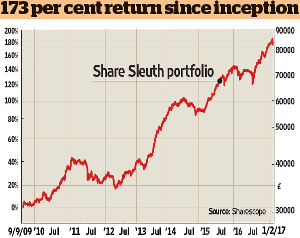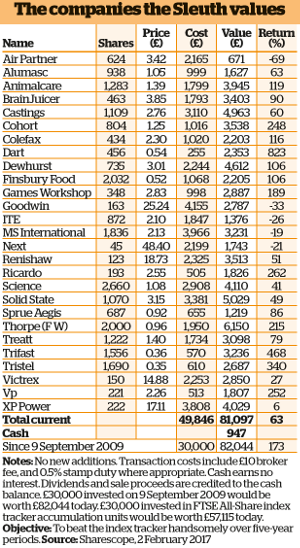Share Sleuth: How to make the PE ratio more useful
3rd March 2017 10:50
by Richard Beddard from interactive investor
Share on
If making money is all you care about, all that matters in stockmarket investment is valuation. Except in the case of a company going bust, any share can be a profitable trade at the right price.
Personally, I care about the kind of businesses I invest in, so I spend time making sure they do something I approve of.
But there's another reason why valuation is my fifth and final criterion, only considered after I'm satisfied that I understand what the company does, and that it's highly profitable, capable of remaining so, and run by executives who should ensure it stays on track.
Price/earnings ratio
I think about the companies first, because you can only value something if you know what it is.
Most investors use relatively simple metrics like the famous price/earnings (PE) ratio to decide whether shares are good value. The 'E' in PE refers to the earnings attributable to shareholders over the financial year. The 'P' is the market price of the company.

Every year we would receive 1/15 of our original investment, which is just under 7%. Expressed as a percentage, the PE becomes an earnings yield, which is like an interest rate.
A company that costs 10 times earnings (its PE is 10) is better value than a company that costs 15 times earnings, because it promises a 10% return as opposed to 7%.
There is a complicating factor, though: the earnings of companies vary a lot from year to year. While a company might earn 7% of our original investment one year, it might earn only 4% another, and 14% a year later. Depending on the company, the figures could be alarming.
For turnarounds, cyclical companies or start-ups, the PE is an unreliable guide - a bit like a compass in the Bermuda Triangle.
Establishing a realistic value for future earnings amid a corporate restructuring or while a company has yet to establish a profitable business model is probably beyond most of us, even sometimes those very close to the situation.
One way around this problem is to stick to the most predictable companies. The purpose of my first four criteria is to find stable businesses where future profits are likely to be much like they were in the past, only somewhat better.
No guarantees
There are no guarantees of course, but over time most of them should earn returns higher than their earnings yields imply, because they can invest in their highly profitable operations and grow.

So how much do you pay for a firm that should perform much like it has in the past, but somewhat better? We answer the question by asking another.
How much do you want to earn? 12 times earnings, a PE of 12, promises an earnings yield of 8%. That's my benchmark for value.
I prefer not to pay more, but I'm prepared to pay up to 20 times earnings, analogous to an earnings yield of 5%, in the expectation that growth will bring returns above the benchmark.
If that sounds arbitrary, it is; but only to a point. The joy of expressing a PE as an earnings yield is that you can compare it with the alternatives.
My expected minimum return of 8% average over at least 10 years compares very favourably with yields on bonds and the interest on cash deposits.
Shares are more risky, we're told. However, not only am I expecting a higher return, but the first four criteria should have directed me to the most stable companies. The least risky, in other words.
This article is for information and discussion purposes only and does not form a recommendation to invest or otherwise. The value of an investment may fall. The investments referred to in this article may not be suitable for all investors, and if in doubt, an investor should seek advice from a qualified investment adviser.
These articles are provided for information purposes only. Occasionally, an opinion about whether to buy or sell a specific investment may be provided by third parties. The content is not intended to be a personal recommendation to buy or sell any financial instrument or product, or to adopt any investment strategy as it is not provided based on an assessment of your investing knowledge and experience, your financial situation or your investment objectives. The value of your investments, and the income derived from them, may go down as well as up. You may not get back all the money that you invest. The investments referred to in this article may not be suitable for all investors, and if in doubt, an investor should seek advice from a qualified investment adviser.
Full performance can be found on the company or index summary page on the interactive investor website. Simply click on the company's or index name highlighted in the article.
Disclosure
We use a combination of fundamental and technical analysis in forming our view as to the valuation and prospects of an investment. Where relevant we have set out those particular matters we think are important in the above article, but further detail can be found here.
Please note that our article on this investment should not be considered to be a regular publication.
Details of all recommendations issued by ii during the previous 12-month period can be found here.
ii adheres to a strict code of conduct. Contributors may hold shares or have other interests in companies included in these portfolios, which could create a conflict of interests. Contributors intending to write about any financial instruments in which they have an interest are required to disclose such interest to ii and in the article itself. ii will at all times consider whether such interest impairs the objectivity of the recommendation.
In addition, individuals involved in the production of investment articles are subject to a personal account dealing restriction, which prevents them from placing a transaction in the specified instrument(s) for a period before and for five working days after such publication. This is to avoid personal interests conflicting with the interests of the recipients of those investment articles.